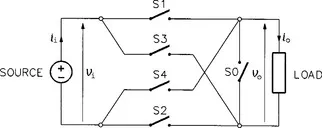1.1 PRINCIPLES OF ELECTRIC POWER CONDITIONING
Electric power is supplied in a “raw,” fixed-frqency, fixed-voltage form. For small consumers, such as homes or small stores, usually only the single-phase ac voltage is available, whereas large energy users, typically industrial facilities, draw most of their electrical energy via three-phase lines. The demand for conditioned power is growing rapidly, mostly because of the progressing sophistication and automation of industrial processes. Power conditioning involves both power conversion, ac to dc or dc to ac, and control. Power electronic converters performing the conditioning are highly efficient and reliable.
Power electronic converters can be thought of as networks of semiconductor power switches. Depending on the type, the switches can be uncontrolled, semicontrolled, or fully controlled. The state of uncontrolled switches, the power diodes, depends on the operating conditions only. A diode turns on (closes) when positively biased and it turns off (opens) when the conducted current changes its polarity to negative. Semicontrolled switches, the SCRs (silicon controlled rectifiers), can be turned on by a gate current signal, but they turn off just like the diodes. Most of the existing power switches are fully controlled, that is, they can both be turned on and off by appropriate voltage or current signals.
Principles of electric power conversion can easily be explained using a hypothetical “generic power converter” shown in Fig. 1.1. It is a simple network of five switches, S0 through S4, of which S1 opens and closes simultaneously with S2, and S3 opens and closes simultaneously with S4. These four switches can all be open (OFF), but they may not be all closed (ON) because they would short the supply source. Switch S0 is only closed when all the other switches are open. It is assumed that the switches open and close instantly, so that currents flowing through them can be redirected without interruption.
FIGURE 1.1 Generic power converter.
The generic converter can assume three states only: (1) State 0, with switches S1 through S4 open and switch S0 closed, (2) State 1, with switches S1 and S2 closed and the other three switches open, and (3) State 2, with switches S3 and S4 closed and the other three switches open. Relations between the output voltage, vo, and the input voltage, vi, and between the input current, ii, and output current, i0, are
and
Thus, depending on the state of generic converter, its switches connect, cross-connect, or disconnect the output terminals from the input terminals. In the last case (State 0), switch SO provides a path for the output current (load current) when the load includes some inductance, L. In absence of that switch, interrupting the current would cause a dangerous impulse overvoltage, Ldio/dt → –∞.
Instead of listing the input–output relations as in Eqs. (1.1) and (1.2), the so-called switching functions (or switching variables) can be assigned to individual sets of switches. Let a = 0 when switch SO is open and a = 1 when it is closed, b = 0 when switches S1 and S2 are open and b = 1 when they are closed, and c = 0 when switches S3 and S4 are open and c = 1 when they are closed. Then,
and
The ac to dc power conversion in the generic converter is performed by setting it to State 2 whenever the input voltage is negative. Vice-versa, the dc to...





